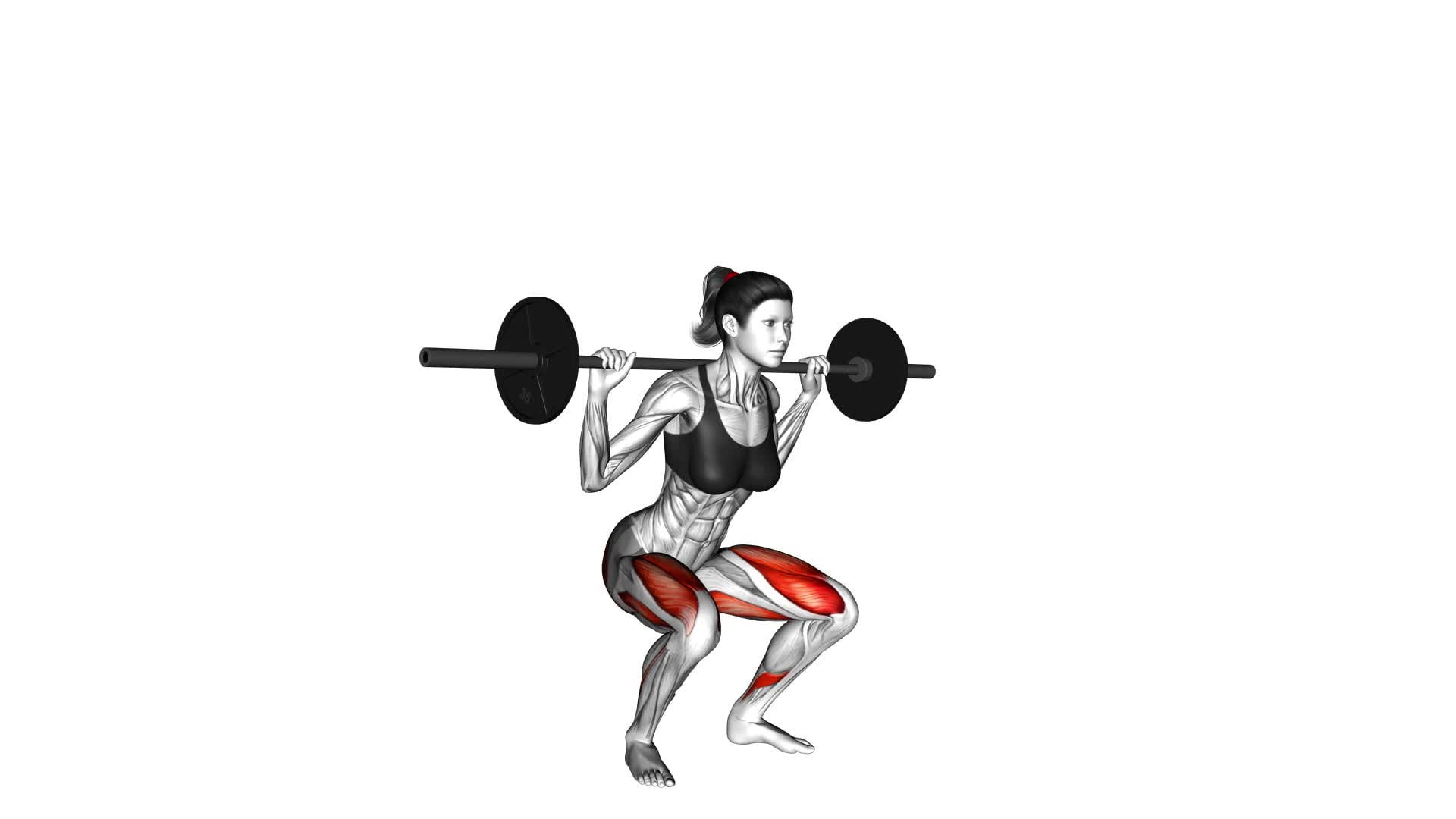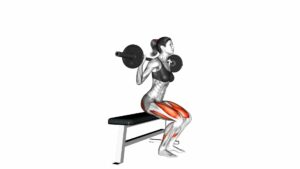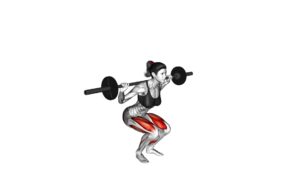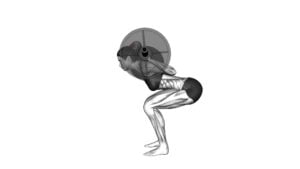Barbell Squat (female) – Video Exercise Guide & Tips

Are you a woman looking to strengthen and tone your lower body? Look no further than the barbell squat!
Watch This Exercise Video
This compound exercise targets your glutes, quads, and hamstrings, helping you build lean muscle and improve overall strength.
In this video exercise guide, you'll find step-by-step instructions and tips on proper set-up, technique, and common mistakes to avoid.
Plus, we'll show you variations to suit your fitness goals.
Get ready to squat like a pro and achieve your fitness goals!
Key Takeaways
- Barbell squats target the glutes, quads, and hamstrings, helping to build lean muscle and improve overall strength.
- Barbell squats enhance cardiovascular endurance, increase bone density, and promote weight loss.
- Proper set-up and grip for barbell squats involve positioning the barbell on the upper back, gripping it with an overhand grip, and maintaining control and stability throughout the exercise.
- The correct squatting technique for women focuses on hip and knee alignment, core engagement, and foot positioning for stability and proper form.
Benefits of Barbell Squats for Women
Discover the numerous benefits of incorporating barbell squats into your workout routine as a woman. Barbell squat variations are an excellent choice for strength training, as they target multiple muscle groups simultaneously. When you perform a barbell squat, you engage your quadriceps, hamstrings, glutes, and core muscles, resulting in increased strength and stability.
One of the key benefits of barbell squats is their ability to improve overall fitness. By incorporating this exercise into your routine, you can enhance your cardiovascular endurance, increase bone density, and improve flexibility. Additionally, barbell squats can help you burn calories and lose weight, making them an effective tool for achieving your fitness goals.
Furthermore, barbell squats can have a positive impact on your daily life. Strengthening your lower body muscles through squats can improve your posture and balance, reducing the risk of falls and injuries. This exercise also promotes functional strength, which translates to better performance in activities like lifting heavy objects or participating in sports.
Incorporating various barbell squat variations, such as front squats or sumo squats, can add variety to your routine and target different muscle groups. By challenging your muscles in different ways, you can continue to make progress and avoid plateaus in your fitness journey.
Proper Set-Up and Grip for Barbell Squats
To ensure proper form and maximize the benefits of barbell squats, it's important for you to set up and grip the barbell correctly. Follow these tips to ensure proper form and get the most out of your barbell squats:
- Positioning: Start by positioning yourself under the barbell. Place the barbell on your upper back, resting it on your trapezius muscles. Make sure the barbell is centered and not too high or too low on your back.
- Grip: Grab the barbell with an overhand grip, slightly wider than shoulder-width apart. Your palms should be facing forward, and your thumbs should be wrapped around the barbell. This grip will help you maintain control and stability throughout the exercise.
- Elbow Position: Keep your elbows pointing down and slightly backward. This will help you maintain stability and prevent your elbows from flaring out during the squat.
- Brace Your Core: Before you start the squat, engage your core by taking a deep breath and tightening your abdominal muscles. This will provide stability and support for your spine during the exercise.
Proper set-up and grip are crucial for maintaining proper form and maximizing the benefits of barbell squats. By following these tips, you can ensure that you're performing the exercise correctly and safely, allowing you to reap the full benefits of this compound exercise.
The Correct Squatting Technique for Women
To perform the barbell squat with correct technique, it's important for women to focus on hip and knee alignment. Ensure that your knees are tracking over your toes and that your hips are properly aligned throughout the movement.
Engaging your core is crucial for stability and to maintain proper form. Additionally, pay attention to your foot positioning, making sure your feet are shoulder-width apart and pointing slightly outward to allow for proper alignment and stability.
Hip and Knee Alignment
You should always prioritize proper hip and knee alignment when performing the barbell squat as a female. This is crucial for maintaining knee stability and ensuring that the exercise targets the intended muscles effectively.
Here are some important tips to help you achieve optimal hip and knee alignment:
- Position your feet shoulder-width apart, toes slightly turned out.
- Keep your knees in line with your toes throughout the entire movement.
- Engage your glutes by pushing your hips back as you lower into the squat.
- Maintain a neutral spine by keeping your chest lifted and your core engaged.
By following these guidelines, you can minimize the risk of injury and maximize the benefits of the barbell squat.
Core Engagement Importance
Maintaining proper core engagement is essential for women to execute the correct squatting technique. It's crucial to understand the benefits of core engagement and the importance of proper form.
When you engage your core during a squat, you activate the muscles in your abdomen, back, and pelvis, which helps stabilize your spine and maintain an upright posture. This not only enhances your overall strength but also reduces the risk of injuries.
By keeping your core engaged, you create a solid foundation for the movement, allowing you to generate power from your lower body efficiently. Additionally, proper core engagement ensures that your weight is evenly distributed, preventing excessive strain on your knees and hips.
Foot Positioning Tips
Proper foot positioning is crucial for women to achieve the correct squatting technique. Here are some foot positioning tips to help you perform the barbell squat effectively:
- Alignment: Ensure that your feet are shoulder-width apart and parallel to each other. This alignment helps distribute the load evenly and prevents any unnecessary strain on your knees.
- Weight Distribution: Place your weight on your heels rather than your toes. This technique helps engage your glutes and hamstrings while maintaining balance.
- Toes Pointing Outward: Angle your toes slightly outward, around 10 to 30 degrees. This position allows for better stability and helps activate your inner thigh muscles.
- Avoiding Common Mistakes: Avoid letting your knees collapse inward or letting them extend too far over your toes. This can lead to knee injuries and improper form. Focus on keeping your knees aligned with your toes throughout the movement.
Common Mistakes to Avoid During Barbell Squats
When performing barbell squats, it's important to be mindful of certain common mistakes that can hinder your progress.
One common mistake is improper knee alignment, where the knees collapse inward instead of tracking over the toes. This can put unnecessary stress on the knees and increase the risk of injury.
Another mistake to avoid is a lack of core engagement, as this can lead to a loss of stability and compromise your form.
Lastly, be cautious of not reaching the proper depth in your squat, as this can limit the effectiveness of the exercise and prevent you from fully engaging your lower body muscles.
Knee Alignment Issues
You should ensure that your knees are properly aligned during barbell squats to avoid common mistakes. Proper knee alignment is essential for maintaining knee stability and preventing injuries.
Here are some tips to help you achieve correct knee alignment during barbell squats:
- Maintain a neutral foot position: Make sure your feet are parallel and shoulder-width apart. Avoid turning your toes inward or outward, as this can put unnecessary stress on your knees.
- Track your knees over your toes: As you squat, your knees should track over your toes. Avoid letting them cave inwards or push too far forward, as this can strain the knee joint.
- Engage your glutes and hamstrings: By activating the muscles in your glutes and hamstrings, you can help stabilize your knees and protect them during the squat.
- Incorporate knee strengthening exercises: Strengthening the muscles around your knees can improve knee stability. Include exercises like lunges, step-ups, and leg presses in your workout routine to help strengthen your knees.
Lack of Core Engagement
To prevent a lack of core engagement and common mistakes during barbell squats, it's crucial to focus on activating and strengthening your core muscles. Core stability is essential for maintaining proper form and preventing injury during this exercise. When your core is engaged, it helps to stabilize your spine, allowing you to lift heavier weights safely and efficiently.
To improve your core stability, incorporate specific strengthening exercises into your workout routine. Planks, Russian twists, and bicycle crunches are all effective exercises that target your core muscles. By consistently incorporating these exercises into your routine, you'll develop a stronger and more stable core, which will greatly enhance your performance and overall safety during barbell squats.
Improper Depth of Squat
To ensure proper form and avoid common mistakes during barbell squats, it's crucial to maintain the correct depth of the squat. Improper form, such as not reaching the appropriate depth, can increase the risk of injuries and limit the effectiveness of the exercise. Here are some key tips to help you prevent these issues:
- Don't squat too shallow: Going too high on the squat can put excessive strain on your knees and limit the activation of your glutes and hamstrings.
- Avoid squatting too deep: Going too low can cause your lower back to round, increasing the risk of injury. Aim to squat until your hip crease is slightly below your knees.
- Maintain a neutral spine: Keep your chest up and your back straight throughout the movement to ensure proper alignment and prevent unnecessary stress on your spine.
- Use a mirror or have a spotter: Utilize visual feedback or have someone watch your form to ensure you're reaching the correct depth without compromising your form.
By maintaining the proper depth of the squat, you can maximize your gains while preventing injuries.
Now, let's move on to the next section where we'll discuss tips for increasing resistance and intensity.
Tips for Increasing Resistance and Intensity
To effectively increase resistance and intensity during the barbell squat, incorporate heavier weights into your training routine. Increasing the resistance is essential for progressive overload, which is the key to building strength and muscle. Gradually increasing the weight will challenge your muscles and force them to adapt and grow stronger over time.
When adding resistance to your barbell squat, it's important to do so in a controlled and safe manner. Start by adding small increments of weight, such as 5-10 pounds, to the barbell. This will allow your body to adjust to the added load and ensure proper form and technique.
As you become more comfortable with the increased weight, continue to gradually add more resistance. Aim to increase the weight by 5-10% each week or every other week, depending on your individual progress and capabilities.
In addition to increasing the weight, you can also enhance the intensity of your barbell squat by incorporating other variations into your routine. This can include using different foot positions, performing pause squats, or adding in explosive movements like jump squats.
Remember to listen to your body and progress at a pace that's appropriate for your fitness level. Pushing yourself too hard or too quickly can lead to injury. By gradually increasing the resistance and intensity of your barbell squat, you'll continue to challenge and strengthen your muscles, ultimately achieving your fitness goals.
Barbell Squat Variations for Female Fitness Goals
If you're a female looking to achieve specific fitness goals, there are various barbell squat variations that can help you target different muscle groups and work towards your objectives. Incorporating these variations into your workout routine can provide numerous benefits for your overall fitness.
Here are four barbell squat variations that are suitable for different body types and can help you achieve your fitness goals:
- Sumo Squat: This variation targets your inner thighs and glutes more intensely. By taking a wider stance and pointing your toes outwards, you can activate different muscle fibers and work on developing a strong lower body.
- Front Squat: The front squat places more emphasis on your quadriceps and core muscles. By positioning the barbell on the front of your shoulders and keeping your torso upright, you can challenge your muscles in a different way and improve your overall strength.
- Bulgarian Split Squat: This variation is excellent for targeting each leg individually and improving balance. By elevating one foot on a bench or step behind you and performing a squat, you can focus on developing strength and stability in each leg separately.
- Box Squat: Incorporating a box squat into your routine can help you improve your squat depth and build explosive power. By squatting down onto a box or bench and then explosively standing back up, you can enhance your overall squat performance and develop stronger lower body muscles.
Frequently Asked Questions
How Often Should Women Incorporate Barbell Squats Into Their Workout Routine?
To maximize the benefits of barbell squats for women, it's important to incorporate them into your workout routine regularly.
The ideal workout frequency for barbell squats may vary depending on individual fitness goals and overall strength level. However, a general guideline is to aim for at least two to three sessions per week.
Regularly performing barbell squats can help improve lower body strength, build muscle, increase bone density, and enhance overall athletic performance.
Can Barbell Squats Help Women in Improving Their Posture?
Barbell squats can be beneficial for women in improving their posture.
By engaging the muscles in your lower body, barbell squats help to strengthen your legs, glutes, and core, which are all vital for maintaining proper alignment and balance.
As you perform this exercise, you'll develop a stronger foundation, leading to better posture throughout your daily activities.
Adding barbell squats to your routine can help you improve your balance and increase your lower body strength, ultimately enhancing your overall posture.
Are There Any Specific Warm-Up Exercises That Women Should Perform Before Attempting Barbell Squats?
Before attempting barbell squats, it's important for women to perform specific warm-up exercises to prepare their bodies. Incorporating a warm-up routine into your workout helps prevent injury and improves overall performance.
By engaging in preparation exercises such as dynamic stretching, foam rolling, and activation drills, you can effectively warm up your muscles, increase blood flow, and enhance your range of motion.
This will ensure that you're ready to safely and effectively perform barbell squats.
Is It Normal to Feel Soreness in Certain Muscles After Doing Barbell Squats?
Feeling soreness in certain muscles after doing barbell squats is normal. It's a sign that your muscles are being activated and worked effectively.
To minimize soreness, make sure you're using proper form and technique during your squats. This includes maintaining a straight back, keeping your knees in line with your toes, and going down to a comfortable depth.
Gradually increasing the weight and incorporating rest days can also help reduce muscle soreness.
Can Barbell Squats Help Women in Reducing Cellulite?
Barbell squats are one of the best exercises for reducing cellulite. By engaging multiple muscle groups, they help to tone and tighten your legs and buttocks, reducing the appearance of cellulite.
The benefits of barbell squats for women are numerous, including increased strength, improved muscle definition, and enhanced overall fitness.
Conclusion
In conclusion, barbell squats are a highly beneficial exercise for women, offering a range of advantages such as strengthening the lower body, improving overall fitness, and increasing bone density.
By following the proper set-up and grip techniques, as well as using the correct squatting technique, women can avoid common mistakes and ensure optimal results.
Additionally, incorporating variations and gradually increasing resistance and intensity can help women achieve their specific fitness goals.
So grab that barbell and start squatting for a stronger, fitter you!

Author
Years ago, the spark of my life’s passion ignited in my mind the moment I stepped into the local gym for the first time. The inaugural bead of perspiration, the initial endeavor, the very first surge of endorphins, and a sense of pride that washed over me post-workout marked the beginning of my deep-seated interest in strength sports, fitness, and sports nutrition. This very curiosity blossomed rapidly into a profound fascination, propelling me to earn a Master’s degree in Physical Education from the Academy of Physical Education in Krakow, followed by a Sports Manager diploma from the Jagiellonian University. My journey of growth led me to gain more specialized qualifications, such as being a certified personal trainer with a focus on sports dietetics, a lifeguard, and an instructor for wellness and corrective gymnastics. Theoretical knowledge paired seamlessly with practical experience, reinforcing my belief that the transformation of individuals under my guidance was also a reflection of my personal growth. This belief holds true even today. Each day, I strive to push the boundaries and explore new realms. These realms gently elevate me to greater heights. The unique combination of passion for my field and the continuous quest for growth fuels my drive to break new ground.







